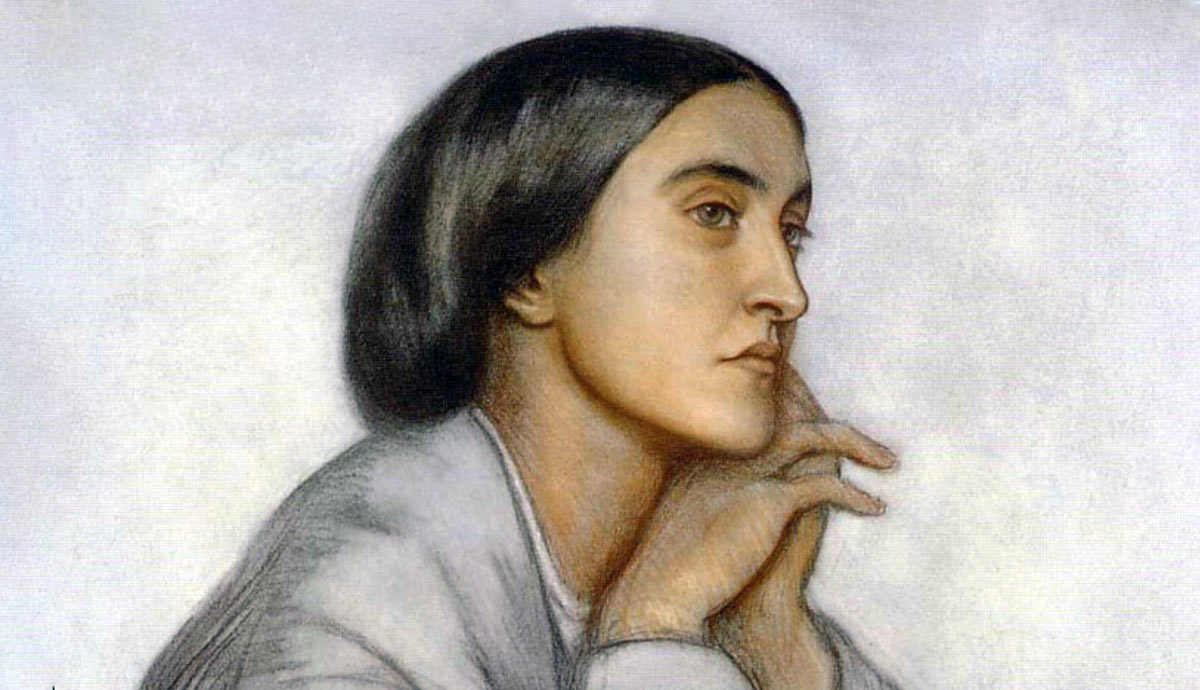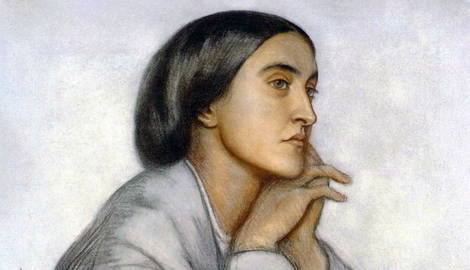
Beginning with Horace Walpole’s 1764 novel The Castle of Otranto, literature and architecture began to develop a unique relationship in Great Britain. Throughout the 18th and 19th centuries, British authors wrote poetry, novels, and short stories that evoked the mystery and drama of the Gothic Revival architecture that had risen to prominence. Famous authors associated with Gothic literature included Horace Walpole and the Brontë sisters. Inspired by the authors who had preceded her, Christina Rossetti was an influential voice in transmitting Gothic themes in literature in the 19th century.
Christina Rossetti and the Shadow of the Gothic Revival

A general resurgence of interest in Gothic architecture began in Great Britain in the 18th century. In what became known as the Gothic Revival, many structures throughout Great Britain began flaunting Gothic architectural features unabashedly. Prominent works of architecture that embraced the Gothic Revival were the Palace of Westminster, which emulated the Perpendicular Gothic style, and Balmoral Castle, which featured a variant known as Scottish Baronial.
Interestingly, the first work of Gothic literature, The Castle of Otranto, was written by Horace Walpole, a politician who constructed the Gothic Revival villa Strawberry Hill House for himself. Unsurprisingly, The Castle of Otranto is a work heavily inspired by Gothic architecture, with the events of the plot revolving around the titular castle and the mysteries that surround it. This combination of imposing architecture and plots driven by mystery and fantasy became the defining elements of many works of Gothic literature by British authors, including Charlotte Brontë’s Jane Eyre and Daphne du Maurier’s Rebecca.

The Gothic Revival and its impact on literature undoubtedly cast a shadow over Christina Rossetti’s childhood. Her uncle, John William Polidori, wrote the 1819 short story The Vampyre, one of the 19th century’s most iconic works of Gothic literature. Polidori’s life itself, which involved a close relationship with the adventurous Lord Byron and a suicide at the young age of 26, may have felt like a Gothic novel in and of itself to the young Rossetti. The constant presence of his portrait, which Rossetti’s mother displayed proudly in their home, must have been a haunting presence throughout her youth.
She herself developed a taste for Gothic tales as a teenager, with her earliest poems being heavily influenced by the genre. Many of the poems and stories that Rossetti penned throughout her career demonstrate an inheritance from a line of female writers of Gothic fiction that had come before her. While some of these authors aligned themselves more closely with Gothic themes than others, their collective works explored these themes from a distinctly female perspective, which undoubtedly inspired Rossetti.
Georgiana Fullerton

An early but tangible tie between Christina Rossetti and a writer of Gothic fiction lies with the author Georgiana Fullerton. Like Rossetti, Fullerton was a woman of deep religious conviction, whose beliefs had a major impact on her writing. Georgiana Fullerton was born in 1812 into a noble family and married a member of the British diplomatic service in 1833. While living in Europe with him, she converted from the Church of England to Catholicism.
Remaining devout for the rest of her life, her writings were marked by strong Catholic themes. Many of Fullerton’s works demonstrate an awareness of the popularity of the Gothic in both architecture and literature. Her 1844 novel Ellen Middleton, for instance, references Gothic architecture, and her 1853 novel Lady-Bird has been interpreted as a Catholic reimagining of the Gothic romance Jane Eyre. Her most explicitly Gothic novel was Grantley Manor (1847), which featured many of the genre’s typical tropes, including a mysterious mansion as its setting and a young woman trying to uncover her family’s hidden secrets as its heroine.
It is known that Christina Rossetti was aware of Fullerton’s work as a teenager, as one of her earliest poems was written in response to Fullerton’s novel Ellen Middleton. Her later work also seems to demonstrate an awareness of the more explicitly Gothic Grantley Manor. Her poem The Poor Ghost of 1863, for instance, may have been the author’s own interpretation of events that are implied to have taken place after the novel’s ending. Fullerton ends her novel with the implication that one of the novel’s heroines, Ginevra, may die shortly after she marries her true love. The Poor Ghost involves an interaction between a deceased woman and her living lover, exploring the theme of inevitable separation brought on by death.
Ann Radcliffe

One of the authors that Christina Rossetti read most voraciously in her youth was Ann Radcliffe. While The Castle of Otranto had been the initiator of Gothic literature, the works of Ann Radcliffe codified it into its own distinct genre. Born in London in 1764, Radcliffe had written many highly influential works by the end of the 18th century, including A Sicilian Romance (1790), Romance of the Forest (1791), The Mysteries of Udolpho (1794), and The Italian (1797). Ann Radcliffe’s works contained many tropes that came to define Gothic literature, including virtuous heroines, shadowy villains, and, above all, awe-inspiring Gothic structures in rugged landscapes. So well-known were her works in English society that Jane Austen referenced them multiple times in her novels. The Romance of the Forest is mentioned in Emma, and The Mysteries of Udolpho is referenced in Northanger Abbey.
Christina Rossetti was a great admirer of Radcliffe’s work and even attempted to write a biography of Radcliffe at one point during her career. Rossetti particularly admired Radcliffe’s The Italian. This novel tells the story of Ellena di Rosalba, whose adventures include being forced into a nunnery to keep her away from her love interest. This theme of incarceration, and of being barred from living a full life, had an influence on Rossetti and can be felt in many of her poems.
One such poem is 1856’s Shut Out, in which a speaker is incarcerated by an eerie spirit. Rossetti employs many instances of Gothic language here, describing the iron bars of a prison cell and the spirit as “blank and unchanging like the grave.” This imagery of a dark and sinister figure locking up a sympathetic soul seems to have been lifted from The Italian, showing a clear connection between Rossetti’s poetry and that of the famous Gothic author.
Letitia Elizabeth Landon

Christina Rossetti was also influenced by Letitia Elizabeth Landon, who wrote poems, novels, and short stories. Born in 1802, Landon became famous for her passionate poetry, which dealt with love, loss, abandonment, and madness. Landon’s writings have been more frequently assessed within the context of early nineteenth-century Romanticism than the Gothic Revival. Nevertheless, it is possible to sense Gothic themes in her work, especially in her poem The Fairy of the Fountains (1835) and her short story The Bride of Lindorf (1836). Landon’s personal life was riddled with scandal, as she secretly bore three children to her married editor. While she did eventually marry another, she was found dead not long afterward on an island off the coast of Ghana.
Landon’s particular approach to Gothic themes is reflected in a 1859 poem that Rossetti dedicated to Landon, entitled L.E.L., a reference to the way Landon often signed her work. In the poem, Rossetti characterizes Landon as a figure who outwardly appears merry and vivacious, but who internally has a heart “breaking for a little love.” This characterization seems to stem from Landon’s own characters, specifically the character of Pauline in The Bride of Lindorf. In the short story, Pauline appears to be a social butterfly publicly, but she secretly suffers from heartbreak.
It is important to note that Pauline is ultimately murdered by her own mentally ill sister towards the end of the tale. By characterizing Landon so similarly to Pauline, Rossetti posits that Landon’s death, which was ruled as an accidental suicide, was equally sudden and tragic. While Rossetti attempts to paint death as a positive reunion with all things holy in the poem, the untimely deaths of both women give L.E.L. a strongly Gothic undertone.
Gothic Themes in the Writings of Christina Rossetti

Having been influenced by renowned authors of Gothic literature who had come before her, Gothic themes remained with Christina Rossetti throughout her career. As stated earlier, they were particularly apparent in her earliest works. The 1847 Zara, for example, is intensely Gothic, exploring the overwrought emotions of a heroine denouncing her lover, complete with references to graveyards and intense thunder and lightning. Gothic themes continued to appear in her later works, even unpublished ones. The 1857 unpublished poem A Coast-Nightmare, for example, is undoubtedly one of her most unsettling works. In it, she describes a deceased lover who haunts her in the form of a ghost. Ghosts are a strong Gothic motif, and she relishes in the horror of the experience with the words:
Without a voice he tells me The wordless secrets of death’s deep:If I sleep, his trumpet voice compels me To stalk forth in my sleep:If I wake, he hunts me like a nightmare; I feel my hair stand up, my body creep:Without light I see a blasting sight there, See a secret I must keep.

Rossetti’s most famous poem, Goblin Market (1862), has also been described by some scholars as having Gothic themes. At first glance, the poem seems relatively innocent, recounting a simple fable about the encounters a pair of sisters have with whimsical goblins. Nevertheless, the fairytale world of Goblin Market disguises distinct Gothic undertones, with the goblins serving as a corrupting influence as dark as the shadowy figures in any Gothic novel.
The poem’s conclusion, with Laura being cured of her magically induced illness through the devotion of her sister Lizzie, shows Rossetti’s own personal interpretation of the Gothic, in which love and forgiveness can conquer all. Rossetti’s optimistic interpretation of Gothic darkness, which she believed could be defeated with mercy, is likely one of the reasons why the poem stood out on its initial publication. Its unique integration of Gothic themes with a fairytale world resulted in the poem becoming a key influence for the Pre-Raphaelite Brotherhood of artists, with whom Christina Rossetti often collaborated.










